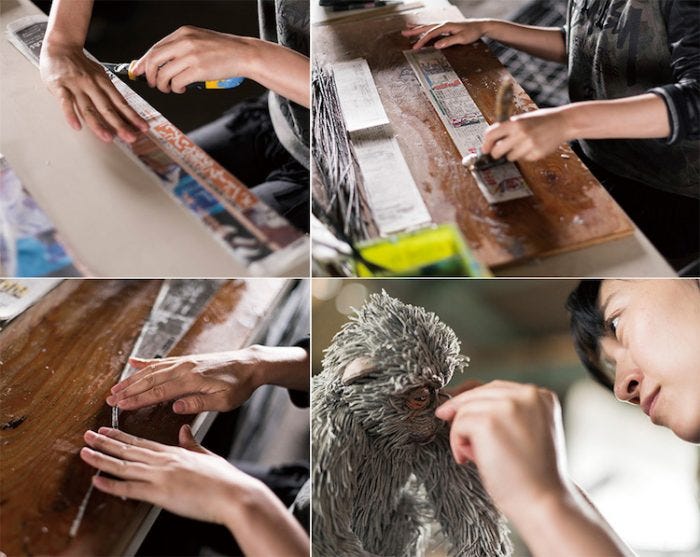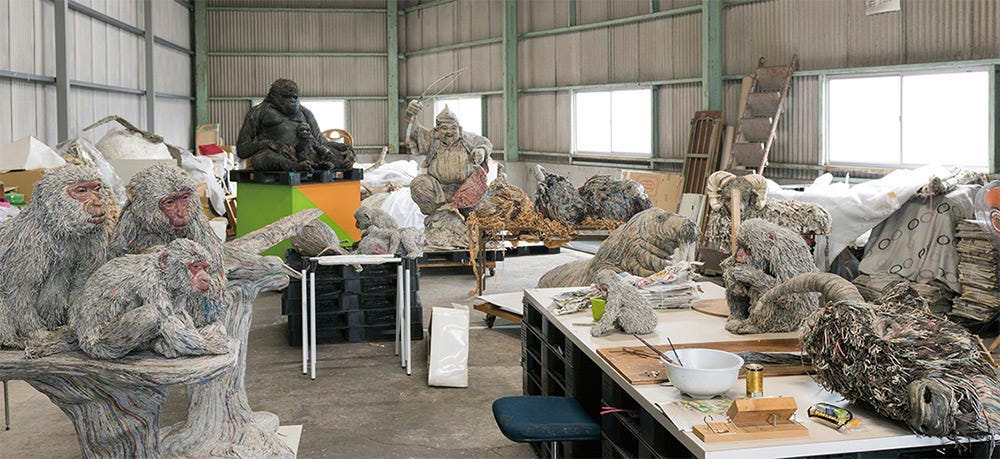The Animal Sculptures giving New Life to Recycled Paper
"I love animals that have strange shapes" Hitotsuyama
Rhinoceros- Chie Hitotsuyama
Japanese paper artist Chie Hitotsuyama deftly creates textured sculptures of animals using a technique involving rolled strips of wet newspaper. The compact application of each newspaper segment proves to be an elegant method of forming the wild fur of snow monkeys or the density of scales found on the back of an iguana. For Hitotsuyama, these details are critical as she seeks to create the most lifelike sculptures possible. (thisiscolossal)
See
“Since the first sculptural piece I made, a rhinoceros, I have continued to sculpt forms of animals and while doing so I have become acutely aware of the life force in all beings. I admire the animals I study. I am in awe of their strength and survival in unforgiving nature.”-Chie Hitotsuyama
To Hear Your Footsteps
Iguana
Chimpanzee #7
Look at the amazing detail and the addition of colored newspapers she uses to add interest into her realistic sculptures.
Her studio is in her grandfather’s Kumihimo (paper braid) factory in Fuji, Japan where there is a large paper industry.
Say
For Japanese artist Chie Hitotsuyama, paper is in her blood. In her grandfather’s old paper-braiding factory, she creates lifelike sculptures of animals by using old newspaper rolled and twisted into intricate shapes. Through a detailed process gleaned in part from her family’s tradition, Hitotsuyama breathes new life into paper waste—taking recycling to a whole new level.
What messages do you glean from Hitosuyama’s work?
If you were going to create an animal sculpture, which animal would you choose and why?
Do
Try creating art using newspaper or old magazines Beads, Papier-mâché and paper bowl are easy options to start with!
Watch Hitosuyama creating in action
About Chie Hitotsuyama
Born in Shizuoka Prefecture in 1982, Ms. Hitotsuyama graduated from the Department of Design at Tokyo Polytechnic University’s Faculty of Arts in 2004. She began to produce three-dimensional works while working as an illustrator after her graduation from the university, and set up the Hitotsuyama Studio upon establishing her current expression, employing twisted newspaper strings that are pasted together. She moved her operating base to Fuji City, Shizuoka Prefecture, in 2011. Ms. Hitotsuyama has since exhibited her artworks in many places around Japan, including the Ginza Mitsukoshi Gallery (in 2013) and the Child Museum at the H.C. Andersen Park in Funabashi City, Chiba Prefecture (in 2014). An artist in the limelight as a contemporary art trailblazer, she has been in constant demand for production and exhibition in Japan and overseas.
“I had no skill for expression. I didn’t know anything. I started from zero and found my way little by little by creating ties with the people I came to know. I truly feel that way.” Through the course of such searches, she arrived at paper strings, which had been imprinted into her memory since childhood. “Until then, I had always felt that I was imitating someone else when I produced an illustration or when I created something. I didn’t know why. At such point, I arrived at paper strings, which occupied a large part of my own background, by repeatedly asking myself what was the unique thing that only I have.” (Full article - Kokusai Pulp and Paper Co)
Follow her on Instagram
Please share your reflections with me by replying to this post, or post and tag my Wonder Wander Facebook or Instagram pages!















What stands out about her work is the family history. Had her grandfather been into glasswork, would her craft been altered by his interest and care? How are our interests and activities formed by those who came before? For example, I would have little patience for paper crafting, but I can crochet for hours...maybe because I saw my granny do it...
I would choose a giraffe, the length of legs and neck representing the news of the day...that which reaches to the heavens for prayer and that which is grounded on earth.